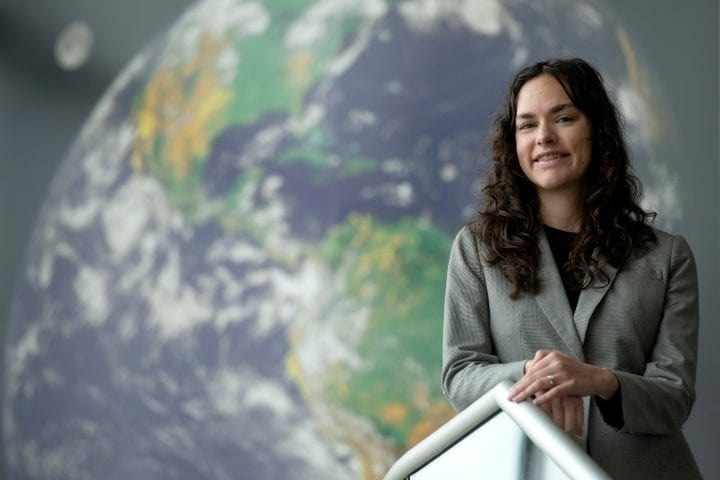Hurricanes and typhoons could get stronger as a result of human-driven climate change. There were previously very few freely accessible computer models created to estimate the financial costs of such events.
 Jane Baldwin, UC Irvine professor of Earth system science, says, “Tropical cyclones are some of the most impactful natural disasters on Earth. They pose huge risks to both human life and the built environment, so they have large economic costs associated with them and cause a lot of deaths. We need to be able to quantitatively explain their risk, meaning the probability of seeing different levels of losses.” Image Credit: Steve Zylius / UCI
Jane Baldwin, UC Irvine professor of Earth system science, says, “Tropical cyclones are some of the most impactful natural disasters on Earth. They pose huge risks to both human life and the built environment, so they have large economic costs associated with them and cause a lot of deaths. We need to be able to quantitatively explain their risk, meaning the probability of seeing different levels of losses.” Image Credit: Steve Zylius / UCI
Now, a team of researchers at the University of California, Irvine, led by Jane W. Baldwin, recently announced the completion of an open-source model that could help nations with high tropical cyclone risks estimate more accurately how much those storms will affect their people and economies.
Tropical cyclones are some of the most impactful natural disasters on Earth. They pose huge risks to both human life and the built environment, so they have large economic costs associated with them and cause a lot of deaths. We need to be able to quantitatively explain their risk, meaning the probability of seeing different levels of losses.
Jane W. Baldwin, Study Lead Author and Professor, Department of Earth System Science, University of California, Irvine
The “Columbia tropical cyclone hazard” model, an existing worldwide tropical cyclone model, is extended by the economic risk model the team created. The economic risk model was originally developed for the Philippines, but it is easily adaptable to any location where interested parties wish to understand the storm risks they face.
Typhoons form over the Northwest Pacific, hurricanes form over the North Atlantic, tropical cyclones form over the Indian Ocean, and storms in the South Pacific and the Indian Ocean are referred to as tropical cyclones.
The advantage of the new model is that it allows nations that might not have access to other risk models and related vulnerability data—which typically belong to for-profit insurance companies that do not openly disclose their products or data—to gain a clearer understanding of the risks they face.
Baldwin added, “That is a strong motivation of the work, to expand the accessibility of tropical cyclone risk information.”
It is one of the reasons why the Philippines was chosen as a case study in the team’s research. According to the study, the Philippines experiences the highest number of landfalling tropical storms on Earth in any given year, but it is considerably less prepared to estimate the damages it may incur as a result.
The new model is remarkable in that it incorporates data from two dissimilar fields: climate change research from specialists such as Baldwin and household vulnerability information obtained from World Bank statistics.
Connecting these data is useful for people-focused disaster preparedness and response. That means rapid assistance to needful households, so that families can meet basic needs, children can return to schools, and communities can build back better.
Brian Walsh, Study Author and Economist, World Bank
Baldwin further stated, “What the model gives is return periods of asset losses, so that means total dollars lost from storms across different regions in the Philippines at different probabilities, at different levels of rarity. There is a pretty strong understanding that the strongest tropical cyclones should become more intense going into the future. But there’s still a lot of disagreement about how you go from that understanding to estimates of risk on the ground that are usable and help people constrain their adaptation needs.”
Beyond estimating monetary expenses, the model can aid countries and even some large municipalities in improving their preparation for a tropical storm by enabling them to pinpoint where they should focus their time and resources while making such preparations.
“There is a growing need to be able to merge information from academic fields like climate science and these more applied risk modeling enterprises. It is a burgeoning field that I am hoping will continue to develop over the next few years of catastrophe modeling as an academic enterprise and not just as a private enterprise. And I think climate change is really pushing the need for that dialogue,” Baldwin concluded.
Researchers from Columbia University in New York, the World Bank in Washington, D.C., and the Lamont-Doherty Earth Observatory in Palisades, New York, collaborated with Baldwin on this project.
Journal Reference:
Baldwin, J. W., et al. (2023) Vulnerability in a Tropical Cyclone Risk Model: Philippines Case Study. Weather, Climate, and Society. doi:10.1175/WCAS-D-22-0049.1.